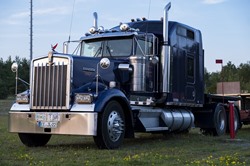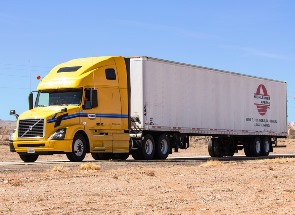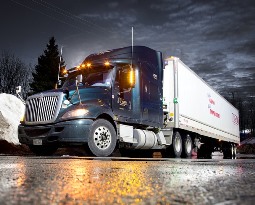How to Choose the Best CDL Driving Classes near Sioux Falls South Dakota
 Congratulations on your decision to become a truck driver and enroll in a CDL school near Sioux Falls SD. Perhaps it has always been your fantasy to hit the open road while operating a monster tractor trailer. Or possibly you have done some analysis and have found that an occupation as a truck driver offers excellent income and flexible work prospects. No matter what your reason is, it’s important to get the proper training by enrolling in the right CDL school in your area. When reviewing your options, there are various factors that you’ll need to consider before making your final selection. Location will certainly be an issue, particularly if you have to commute from your Sioux Falls home. The cost will also be important, but choosing a school based exclusively on price is not the ideal means to guarantee you’ll obtain the proper training. Don’t forget, your goal is to master the skills and knowledge that will enable you to pass the CDL examinations and become a qualified truck driver. So keeping that objective in mind, just how do you pick a truck driving school? The answer to that question is what we are going to discuss in the rest of this article. But first, we are going to review a little bit about which commercial driver’s license you will ultimately need.
Congratulations on your decision to become a truck driver and enroll in a CDL school near Sioux Falls SD. Perhaps it has always been your fantasy to hit the open road while operating a monster tractor trailer. Or possibly you have done some analysis and have found that an occupation as a truck driver offers excellent income and flexible work prospects. No matter what your reason is, it’s important to get the proper training by enrolling in the right CDL school in your area. When reviewing your options, there are various factors that you’ll need to consider before making your final selection. Location will certainly be an issue, particularly if you have to commute from your Sioux Falls home. The cost will also be important, but choosing a school based exclusively on price is not the ideal means to guarantee you’ll obtain the proper training. Don’t forget, your goal is to master the skills and knowledge that will enable you to pass the CDL examinations and become a qualified truck driver. So keeping that objective in mind, just how do you pick a truck driving school? The answer to that question is what we are going to discuss in the rest of this article. But first, we are going to review a little bit about which commercial driver’s license you will ultimately need.
Which Commercial Drivers License Will You Require?
 In order to drive commercial vehicles legally within the USA and Sioux Falls SD, an operator needs to get a CDL (Commercial Driver’s License). The three classes of licenses that one can qualify for are Class A, Class B and Class C. Since the topic of this article is how to choose a truck driving school, we will focus on Class A and B licenses. What distinguishes each class of CDL is the kind of vehicle that the driver can operate as well as the GVWR (Gross Vehicle Weight Rating) or GCWR (Gross Combination Weight Rating). Following are short descriptions for the 2 classes.
In order to drive commercial vehicles legally within the USA and Sioux Falls SD, an operator needs to get a CDL (Commercial Driver’s License). The three classes of licenses that one can qualify for are Class A, Class B and Class C. Since the topic of this article is how to choose a truck driving school, we will focus on Class A and B licenses. What distinguishes each class of CDL is the kind of vehicle that the driver can operate as well as the GVWR (Gross Vehicle Weight Rating) or GCWR (Gross Combination Weight Rating). Following are short descriptions for the 2 classes.
Class A CDL. A Class A Commercial Drivers License is required to operate any vehicle that has a GCWR of greater than 26,000 lbs., including a towed vehicle of greater than 10,000 lbs. Several of the vehicles that operators may be able to drive with Class A licenses are:
- Interstate or Intrastate Tractor Trailers
- Trucks with Double or Triple Trailers
- Tanker Trucks
- Livestock Carriers
- Class B and Class C Vehicles
Class B CDL. A Class B CDL is needed to drive single vehicles having a GVWR of greater than 26,000 lbs., or a GCWR of greater than 26,000 lbs. including a towed vehicle weighing up to 10,000 lbs. A few of the vehicles that drivers may be qualified to operate with Class B licenses are:
- Tractor Trailers
- Dump Trucks
- Cement Mixers
- Large Buses
- Class C Vehicles
Both Class A and Class B CDLs might also require endorsements to operate certain kinds of vehicles, including school or passenger buses. And a Class A licensee, with the appropriate required endorsements, can drive any vehicle that a Class B licensee is qualified to operate.
Click Here to Get Free Information on Truck Driving Schools Near You!
How to Evaluate a CDL School
 When you have determined which Commercial Drivers License you would like to pursue, you can begin the undertaking of researching the Sioux Falls SD truck driving schools that you are looking at. As previously discussed, location and cost will no doubt be your primary considerations. But it can’t be stressed enough that they must not be your sole concerns. Other factors, including the reputations of the schools or the experience of the instructors are equally if not more important. So following are some more points that you need to research while carrying out your due diligence prior to enrolling in, and particularly paying for, your truck driving training.
When you have determined which Commercial Drivers License you would like to pursue, you can begin the undertaking of researching the Sioux Falls SD truck driving schools that you are looking at. As previously discussed, location and cost will no doubt be your primary considerations. But it can’t be stressed enough that they must not be your sole concerns. Other factors, including the reputations of the schools or the experience of the instructors are equally if not more important. So following are some more points that you need to research while carrying out your due diligence prior to enrolling in, and particularly paying for, your truck driving training.
Are the Schools Certified or Accredited ? Not many trucking schools in the Sioux Falls SD area are accredited due to the stringent process and expense to the schools. On the other hand, certification is more common and is offered by the Professional Truck Driver Institute (PTDI). A school is not required to become certified, but there are a number of advantages. Prospective students know that the training will be of the highest caliber, and that they will receive plenty of driving time. As an example, PTDI calls for 44 hours of real driving time, not ride-alongs or simulations. So if a school’s program is certified (the program, not the school is certified), students know that the curriculum and training will satisfy the very high benchmarks set by PTDI.
How Long in Business? One indicator to help measure the quality of a trucking school is how long it has been in operation. A poorly reviewed or a fly by night school typically will not stay in business very long, so longevity is a plus. However, even the top Sioux Falls SD schools had to start from their first day of training, so use it as one of multiple qualifications. You can also learn what the school’s history is relating to successful licensing and employment of its graduating students. If a school won’t supply those stats, look elsewhere. The schools should also have associations with regional and national trucking firms. Having numerous contacts not only confirms an excellent reputation within the profession, but also boosts their job assistance program for students. It also wouldn’t be a bad idea to get in touch with the South Dakota licensing department to confirm that the CDL trucker schools you are reviewing are in compliance.
How Effective is the Training? At a minimum, the schools should be licensed in South Dakota and employ instructors that are experienced and trained. We will talk more about the teachers in the following section. Also, the student to instructor ratio should be no greater than 4 to 1. If it’s any greater, then students will not be getting the personal instruction they will need. This is particularly true concerning the one-on-one instruction for behind the wheel training. And be critical of any school that claims it can train you to be a truck driver in a relatively short time period. Training to be a truck driver and to drive a tractor trailer professionally requires time. The majority of Sioux Falls SD schools offer training courses that run from three weeks to as long as 2 months, based on the class of license or type of vehicle.
How Good are the Instructors? As previously stated, it’s essential that the instructors are trained to teach driving methods and experienced as both drivers and instructors. Although a number of states have minimum driving time requirements to qualify as a teacher, the more successful driving experience an instructor has the better. It’s also important that the instructors stay current with industry developments or any new laws or changes in regulations. Evaluating instructors may be a bit more subjective than other standards, and possibly the ideal method is to pay a visit to the school and speak with the teachers in person. You can also talk to some of the students completing the training and find out if they are happy with the quality of instruction and the teacher’s qualification to train them.
Plenty of Driving Time? Most importantly, an excellent trucking school will provide ample driving time to its students. After all, isn’t that what it’s all about? Driving time is the real time spent behind the wheel driving a truck. While the use of simulators and ride-a-longs with other students are essential training tools, they are no replacement for actual driving. The more training that a student receives behind the wheel, the better driver she or he will be. And even though driving time differs among schools, a reasonable benchmark is 32 hours at a minimum. If the school is PTDI certified, it will furnish a minimum of 44 hours of driving time. Check with the Sioux Falls SD schools you are considering and find out how much driving time they furnish.
Are they Independent or Captive ? You can obtain discounted or even free training from some truck driver schools if you enter into an agreement to drive for a specified carrier for a defined time period. This is referred to as contract training, and the schools that provide it are called captives. So instead of maintaining associations with a wide range of trucking lines that they can refer their students to, captives only work with one company. The tradeoff is receiving less expensive or even free training by giving up the flexibility to initially be a driver wherever you choose. Naturally contract training has the potential to limit your income opportunities when starting out. But for some it may be the only way to obtain affordable training. Just make sure to find out if the Sioux Falls SD schools you are looking at are captive or independent so that you can make an informed decision.
Is there CDL Testing Onsite? There are a number of states that will allow 3rd party CDL testing onsite of truck driver schools for its grads. If onsite testing is permitted in South Dakota, find out if the schools you are considering are DMV certified to provide it. One advantage is that it is more accommodating than contending with graduates of other schools for test times at South Dakota testing centers. It is also an indicator that the DMV views the authorized schools to be of a higher quality.
Are the Classes Flexible? As formerly mentioned, truck driver training is just 1 to 2 months in length. With such a brief duration, it’s essential that the Sioux Falls SD school you choose offers flexibility for both the scheduling of classes and the curriculum. For example, if you’re having a hard time learning a particular driving maneuver, then the teacher should be prepared to devote more time with you until you have it mastered. And if you’re still holding a job while going to training, then the class scheduling needs to be flexible enough to accommodate working hours or other commitments.
Is Job Placement Offered? As soon as you have received your CDL license after graduating from truck driver school, you will be eager to start your new profession. Make sure that the schools you are looking at have job placement programs. Find out what their job placement percentage is and what average salary their graduates start at. Also, find out which local and national trucking companies their graduates are referred to for hiring. If a school has a low job placement rate or not many Sioux Falls SD employers hiring their grads, it might be a sign to search elsewhere.
Is Financial Assistance Offered? Truck driving schools are similar to colleges and other Sioux Falls SD area trade or technical schools when it comes to loans and other forms of financial aid being offered. Ask if the schools you are assessing have a financial aid department, or at a minimum someone who can help you get through the options and forms that need to be submitted.
Top Truck Driving Schools Sioux Falls South Dakota
 Selecting the ideal trucking school is a critical first step to launching your new vocation as a long distance or local truck driver. The skills that you will learn at school will be those that shape a new career behind the wheel. There are many options offered and understanding them is critical if you are going to succeed as an operator. You originally came to our website because of your interest in Top Truck Driving Schools and wanting information on the topic CDL Driving Schools. However, you must obtain the appropriate training in order to drive a large commercial vehicle in a safe and professional manner. If you are lacking money or financing, you might need to look into a captive school. You will pay a reduced or even no tuition by agreeing to drive for their contracted carrier. Or you can choose an independent truck driving school and have the the freedom to drive for the trucking firm of your choice, or one of several affiliated with the school. It’s your choice. But no matter how you receive your training, you will in the near future be part of a profession that helps our country move as a professional truck driver in Sioux Falls SD.
Selecting the ideal trucking school is a critical first step to launching your new vocation as a long distance or local truck driver. The skills that you will learn at school will be those that shape a new career behind the wheel. There are many options offered and understanding them is critical if you are going to succeed as an operator. You originally came to our website because of your interest in Top Truck Driving Schools and wanting information on the topic CDL Driving Schools. However, you must obtain the appropriate training in order to drive a large commercial vehicle in a safe and professional manner. If you are lacking money or financing, you might need to look into a captive school. You will pay a reduced or even no tuition by agreeing to drive for their contracted carrier. Or you can choose an independent truck driving school and have the the freedom to drive for the trucking firm of your choice, or one of several affiliated with the school. It’s your choice. But no matter how you receive your training, you will in the near future be part of a profession that helps our country move as a professional truck driver in Sioux Falls SD.
Truck On in These Other South Dakota Locations
Sioux Falls, South Dakota
Sioux Falls (/ˌsuː ˈfɔːlz/) (Lakota: Íŋyaŋ Okábleča Otȟúŋwahe;[7] "Stone Shatter City") is the most populous city in the U.S. state of South Dakota and the 143rd-most populous city in the United States. It is the county seat of Minnehaha County[8] and also extends into Lincoln County to the south, proximate with the Minnesota state line. It is the 47th-fastest-growing city in the United States[9] and the fastest-growing metro area in South Dakota, with a population increase of 22% between 2000 and 2010.[10]
As of 2019, Sioux Falls had an estimated population of 187,200.[11] The metropolitan population of 259,094 accounts for 29% of South Dakota's population. It is also the primary city of the Sioux Falls-Sioux City Designated Market Area (DMA), a larger media market region that covers parts of four states and has a population of 1,043,450.[12] Chartered in 1856 on the banks of the Big Sioux River, the city is situated in the rolling hills at the junction of Interstate 90 and Interstate 29.
The history of Sioux Falls revolves around the cascades of the Big Sioux River. The falls were created about 14,000 years ago during the last ice age. The lure of the falls has been a powerful influence. Ho-Chunk, Ioway, Otoe, Missouri, Omaha (and Ponca at the time), Quapaw, Kansa, Osage, Arikira, Dakota, and Cheyenne people inhabited and settled the region previous to Europeans and European descendants. Numerous burial mounds still exist on the high bluffs near the river and are spread throughout the general vicinity. Indigenous people maintained an agricultural society with fortified villages, and the later arrivals rebuilt on many of the same sites that were previously settled. Lakota populate urban and reservation communities in the contemporary state and many Lakota, Dakota, and numerous other Indigenous Americans reside in Sioux Falls today.[13]
